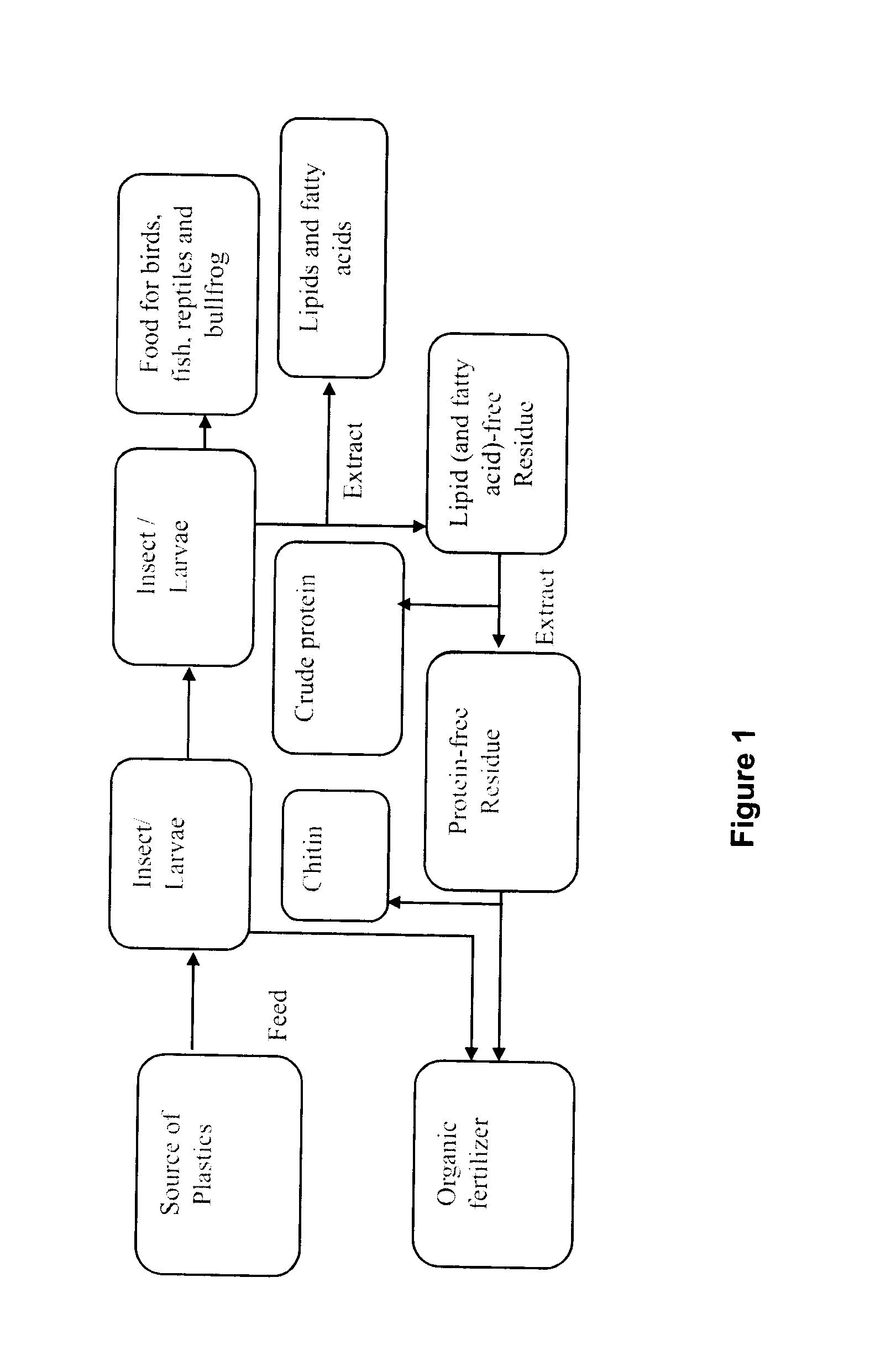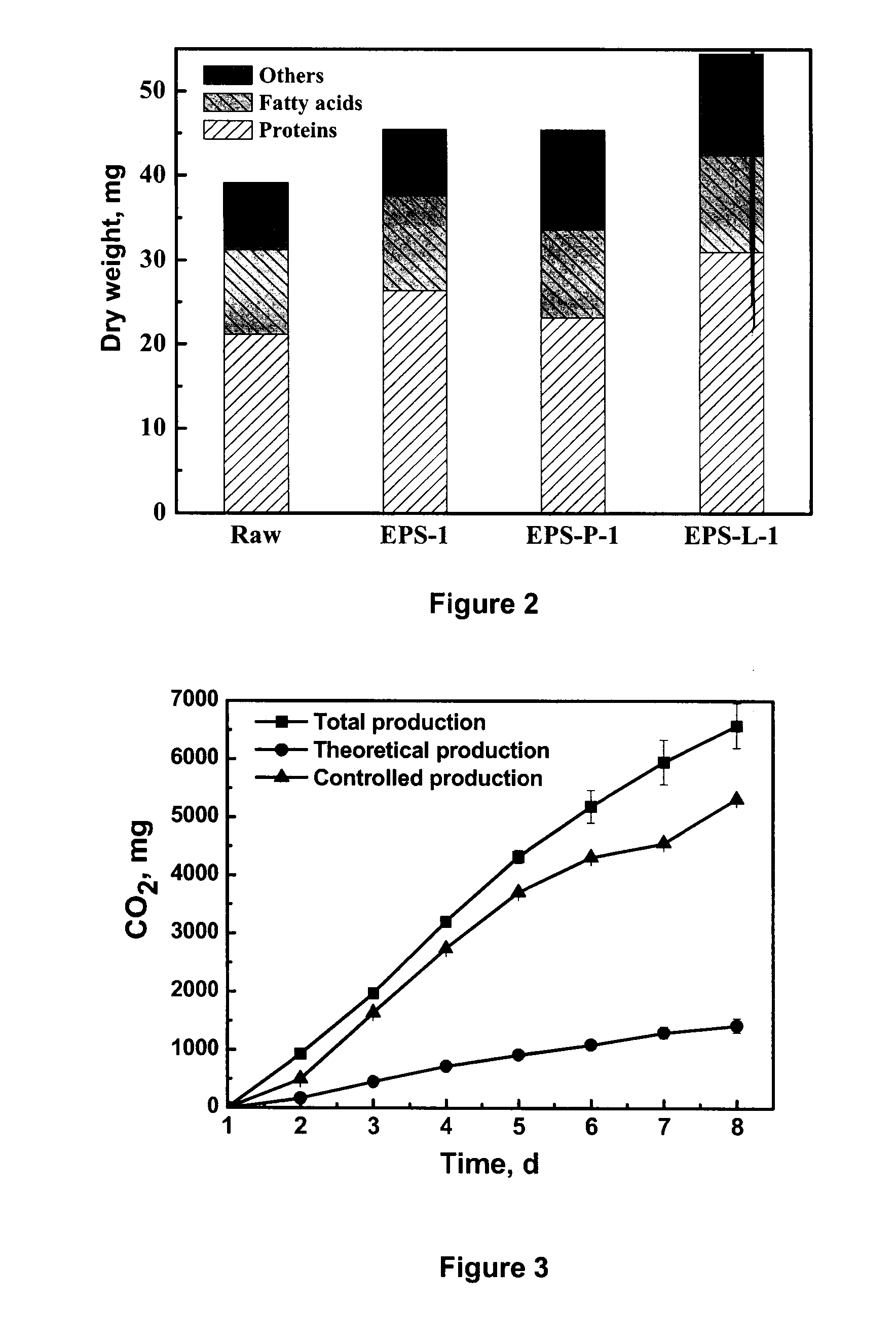Biodegradation of petroleum-based plastics
- Summary
- Abstract
- Description
- Claims
- Application Information
AI Technical Summary
Benefits of technology
Problems solved by technology
Method used
Image
Examples
example 1
Isolation of Petroleum-Based Plastics-Degrading Beetles
[0186]Grain beetles of species Tenebrio molitor Linne were initially observed to consume petroleum-based plastics. Tenebrio molitor Linne was isolated and allowed to multiply for further experiments. Tenebrio molitor Linne larvae were tested for their ability to degrade expanded polystyrene (EPS) in experimental incubators. Larvae were pre-reared on bran, corn, or other agricultural products, and were transferred to their respective experimental incubators after the 2nd to 3rd instar growth stage.
[0187]Incubation conditions were 25° C., 85% humidity, 16:8 hours of light and dark cycle, respectively, and a larval density of 3.5 kg / m2 based on initial larvae weight. A total of 200 pre-reared larvae, without regard to gender, were placed in each experimental incubator for a total of 20 days, after which sampling took place.
[0188]Four duplicate experiments were performed in parallel (for a total of eight incubators), with each exper...
example 2
Degradation of EPS to CO2 by Beetle Larvae X
[0203]Two incubators were prepared with 200 larvae in each one. Larvae were pre-reared as described in Example 1. Incubation conditions were as previously described in Example 1.
[0204]The larvae from the first incubator were fed with expanded polystyrene (EPS, labeled as H-EPS) and the second incubator was not fed with any food under starvation condition (labeled as Control). No vegetable supplementation was used. The CO2 produced by larvae respiration in both incubators were collected. The amount of CO2 from EPS that was broken down into CO2 was measured by precipitating CO2 respired by the larvae in the incubator fed with EPS minus CO2 respired by the larvae in the Control incubator. Briefly, CO2-free air was delivered and flowed through the incubators; effluent air was collected and flowed through a solution of 1M NaOH to remove any CO2 and convert it to sodium carbonate, which was then measured as TIC (Total Inorganic Carbon). The NaOH...
example 3
Degradation of PE by Beetle Larvae and Isolation of Larval Gut Bacteria
[0212]For this Example, the incubation conditions were 25° C., 75% humidity, and dark, respectively. 15 pre-reared Pyralidae Plodia interpunctella larvae were placed into a PE bag (length×width: 14.8 cm into a, film thickness: 0.035 mm) mixed with 150 g sterile millet (water content: 8%). The larvae were then incubated for 28 days and then the frass was collected for analysis.
[0213]High temperature gel permeation chromatography (HT-GPC) analysis indicated that Plodia interpunctella larvae were able to completely depolymerize PE. Comparison of raw PE (dashed line) to frass from PE-fed larvae (solid line) showed an absence of high molecular weight polymer compounds (FIG. 8A).
[0214]The Fourier transform infrared (FTIR) spectroscopy of raw PE (FIG. 8B) and frass from PE-fed larvae (FIG. 8C) supported depolymerization of PE by the loss of spectral peaks characteristic of raw PE, and additional of other peaks non chara...
PUM
| Property | Measurement | Unit |
|---|---|---|
| Temperature | aaaaa | aaaaa |
| Temperature | aaaaa | aaaaa |
| Temperature | aaaaa | aaaaa |
Abstract
Description
Claims
Application Information
 Login to View More
Login to View More - R&D
- Intellectual Property
- Life Sciences
- Materials
- Tech Scout
- Unparalleled Data Quality
- Higher Quality Content
- 60% Fewer Hallucinations
Browse by: Latest US Patents, China's latest patents, Technical Efficacy Thesaurus, Application Domain, Technology Topic, Popular Technical Reports.
© 2025 PatSnap. All rights reserved.Legal|Privacy policy|Modern Slavery Act Transparency Statement|Sitemap|About US| Contact US: help@patsnap.com



